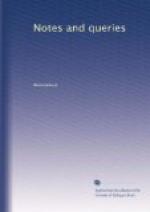“This Madoc arriving in that westerne countrie, unto the which he came, in the year 1170, left most of his people there: and returning backe for more of his owne nation, acquaintance and freends, to inhabite that faire and large countrie: went thither againe with ten sailes, as I find noted by Gutyn Owen. I am of opinion that the land, wherevnto he came, was some part of Mexico:” etc.—David Powel, S.T.P., note in The historie of Cambria, 1584. 4 deg.. p. 229.
[The learned Powel relies
on the authority of the poet Gutyn
Owen. “He wrote,”
says W. Owen, “between A.D. 1460 and
1490”—three
centuries after the event in question!]
Ethnographic evidence.
“They came [anno 1536] to part of the West Indies about Cape Breton, shaping their course thence north-eastwards, vntill they camme to the Island of Penguin,” etc.—The voyage of master Hore, in The principall navigations, etc. 1589. Fol.
[Antiquaries consider the mention of Cape Breton and Penguin Island as evidence. It cannot prove much, as the particulars were not committed to writing till about half-a-century after the voyage.]
“There is also another kinde of foule in that countrey [between the Gulf of Mexico and Cape Breton] ... they have white heads, and therefore the country men call them penguins (which seemeth to be a Welsh nanme). And they have also in use divers other Welsh words, a matter worthy the noting.”—The relation of David Ingram, 1568. in The principall navigations, etc. 1589. Fol.
[This narrative was compiled
from answers to certain
queries—perhaps
twenty years after the events related.]
“Afterwards [anno 1669] they [The Doeg Indians] carried us to their town, and entertained us civilly for four months; and I did converse with them of many things in the British tongue, and did preach to them three times a week in the British tongue,” etc. Rev. Morgan Jones, 1686.—British Remains, 1777. 8 deg..
[The editor omits to state
how he procured the manuscript. The
paper whence the above is
extracted is either decisive of the
question at issue, or a forgery.]
The student may infer, even from these imperfect hints, that I consider the subject which he proposes to himself as one which deserves a strict investigation—provided the collections hereafter described have ceased to be in existence.
“With respect to this extraordinary occurence in the history of Wales, I have collected a multitude of evidences, in conjunction with Edward Williams, the bard, to prove that Madog must have reached the American continent; for the descendants of him and his followers exist there as a nation to this day; and the present position of which is on the southern branches of the Missouri river, under the appellations of Padoucas, White Indians, Civilized Indians, and Welsh Indians.”—William Owen, F.A.S. 1803.
The title prefixed to this paper would be a misnomer, if I did not add a list of books which it may be desirable to consult:—




